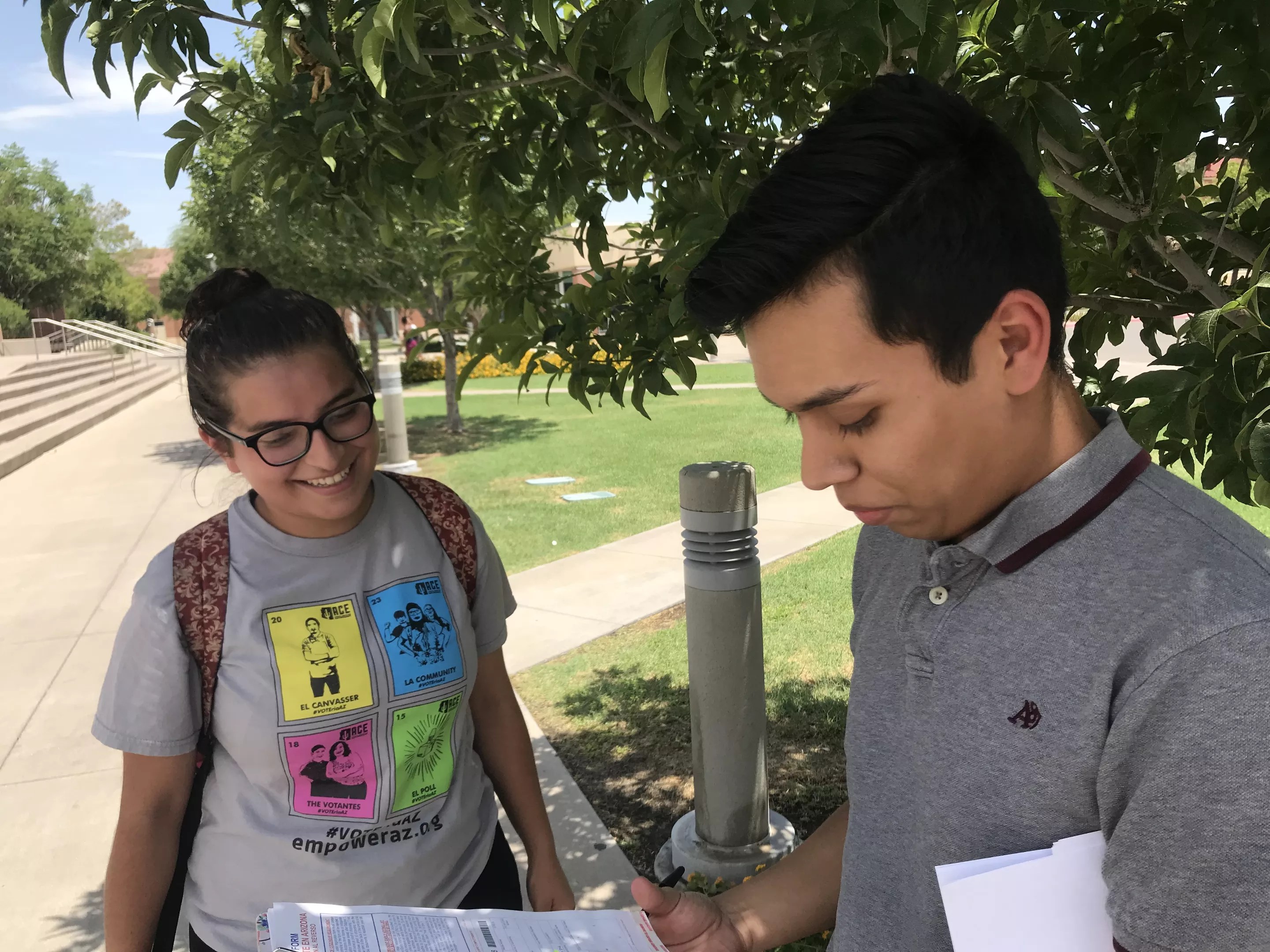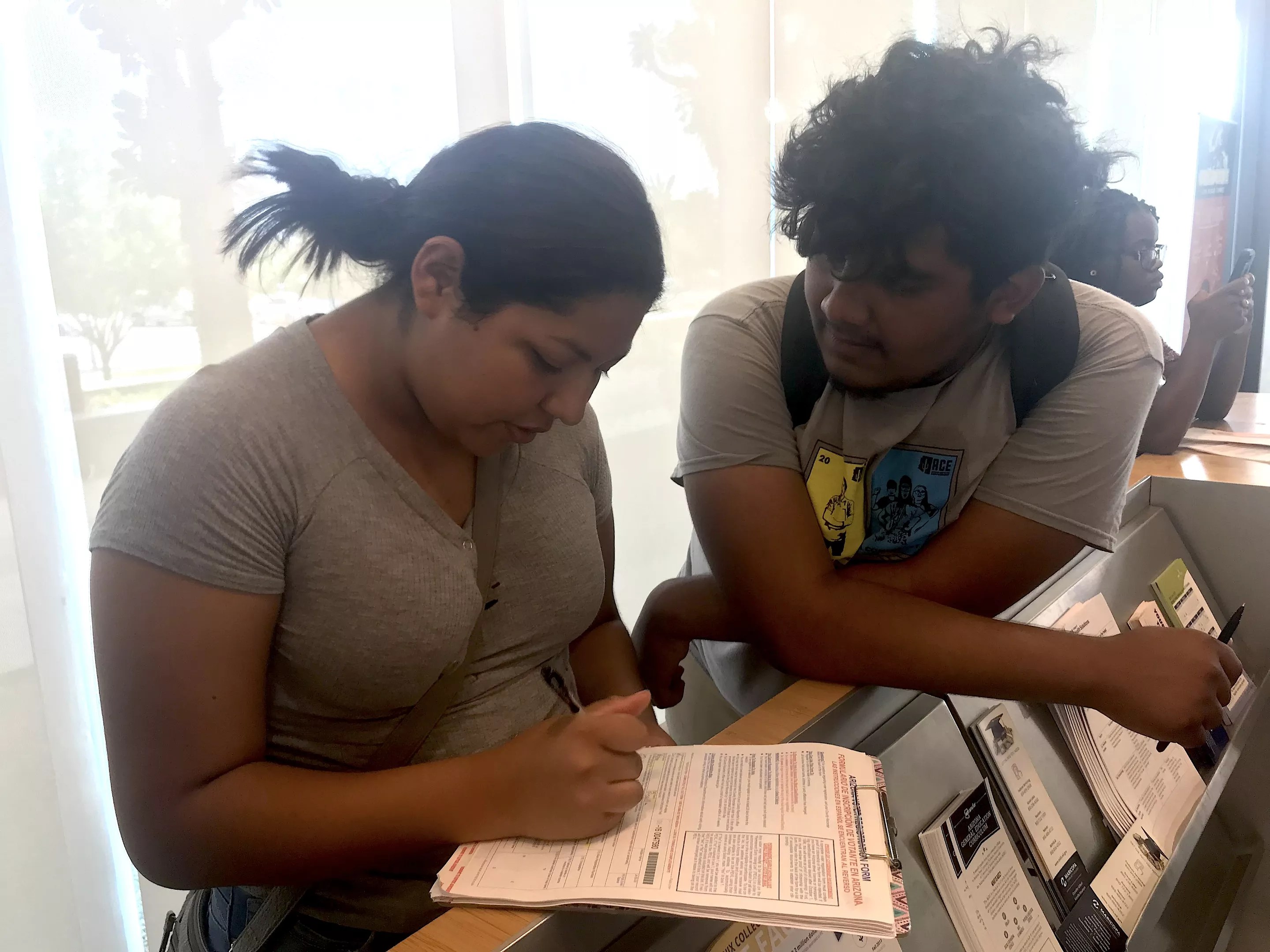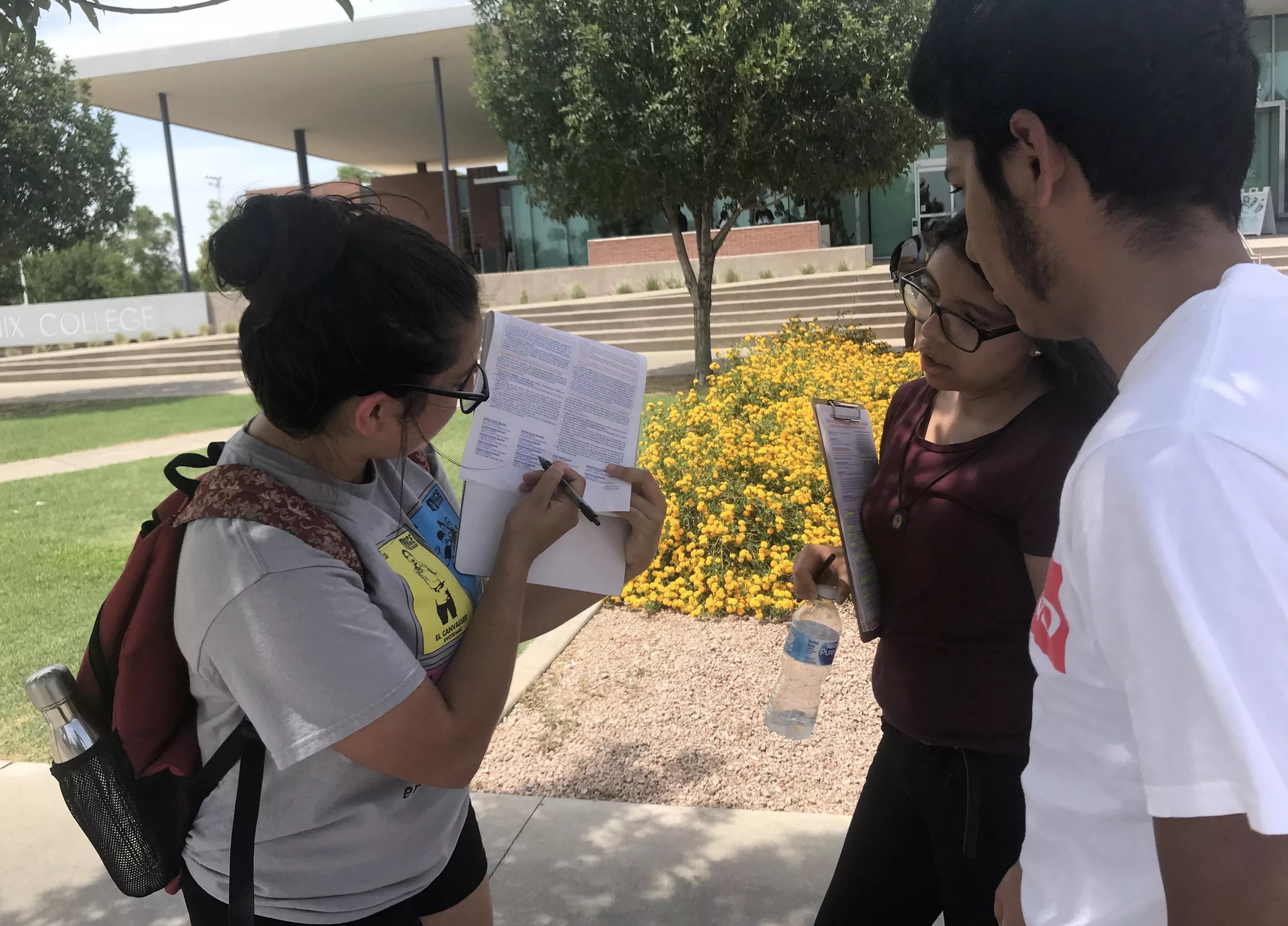
Kelsie Blazier

Audio By Carbonatix
In the months following the February 14 school shooting in Parkland, Florida, voter registration among people under 30 jumped nationwide, with Arizona seeing an 8.2 percent increase, according to a study conducted by TargetSmart, a progressive political data firm.
TargetSmart, founded in 2006, was called “one of the most powerful engines of the Democratic Party’s data operation” by Politico in 2015. It works with Democrats and progressive candidates to collect data, create predictive modeling, and conduct political polling.
Using the date of the shooting – February 14 – as a marker, TargetSmart, looked at voter registration numbers in 39 states (at the time research was conducted 11 states – including swing states New Hampshire and Michigan – had not released voter registration data). The firm then counted voter registration numbers 50 days prior to the shooting, and 50 days after.
In most battleground states among the 39 states reviewed, the number of registered voters within the 18 to 29 age range increased by about 2 percent, the firm’s study states.
Numerically, that equates to 970,058 registered voters nationwide under the age of 30 in the time period prior to the Parkland shooting. That number jumped to over 1.15 million in the subsequent 50 days.
In Arizona, prior to the Parkland shooting, voters under 30 made up 36 percent of new registrants. In the 50 days after Parkland, they made up 44 percent of newly registered voters.
According to a Matt Roberts, a spokesperson for Secretary of State Michelle Reagan, voter registration in Arizona increased by 7 percent in 2018; however, specific causality for the increase is unknown.
“It’s always difficult to attribute increases or decreases to voter registration due to a number of factors,” Roberts said. “Arizona is a growing state and we have people moving here all the time. We also have people leaving the state.”
Sometimes growth is related to the election cycle, a specific legislative issue, or because there are more 18-year-olds registering, Roberts said. “Anytime we see an increase, that’s a good thing.”
Tom Bonier, the CEO of TargetSmart, agrees it’s difficult to definitively attribute increased voter registration to one specific event or date. Though TargetSmart’s data suggests Parkland served as a catalyst for increased voter registration among those under 30, it’s impossible to tell without asking voters individually.
Despite not knowing exactly what spurred increased voter registration, there were shifts in party affiliation among newly registered voters, according to Bonier.
Pre-Parkland, 43.7 percent of voters under 30 registered as Democrats in Arizona; 38.9 percent registered as Republicans; and 17.3 percent were unaffiliated. Post-Parkland, 46.7 registered as Democrats; 35 percent registered as Republicans; and 18.4 percent were unaffiliated.
Statewide, Republicans still represent the majority of registered voters, according to the most recent data provided by the Secretary of State’s office.
Changes in party affiliation, at least for voters under 30, didn’t surprise Jordan Harb, the executive director of Phoenix’s March for Our Lives chapter.
“Because of the 2016 election, most people don’t want to affiliate with any political party,” Harb noted. “A lot of students don’t even know what party they are. They care about issues.”
Harb mentioned the example of Arizona March for Our Lives’ political director, Jacob Martinez, who left his position as chairman of the Arizona Teenage Republicans after the right’s response to Parkland.
Following the events at Marjory Stoneman Douglas, high school students nationwide organized walkouts, “die-ins,” and the March for Our Lives, which drew a crowd of 25,000 of students and gun-control activists in Phoenix. At least 1.3 million people marched nationwide, according to data collected by Jeremy Pressman, Erica Chenoweth, and Kanisha Bond.
Bonier’s own interest in conducting TargetSmart’s research for Analysis: After Parkland Shooting, Youth Voter Registration Surges began when he attended the March for Our Lives rally in Washington, D.C., on March 24.
“Some of the speakers talked about taking momentum from this moment in time and turning it into political power through registration,” Bonier said. “There was an open question among a lot of us. Will this make a difference? Will it be different this time?”
Will it be different this time? According to the Associated Press, March for Our Lives rallies were some of “the biggest youth protests since the Vietnam War.”
March for Our Lives organizers hoped to reform gun laws through legislative measures. They had a list of demands including universal background checks, raising funds for Centers for Disease Control research on gun violence, and banning high-capacity magazines and semiautomatic assault rifles.
Organization leaders quickly realized if any change was going to occur on the state or national level, young voters needed to hit politicians where it would hurt most – the ballot box. Voter registration became a top priority for the movement.
Since the Phoenix March for Our Lives, the student-led organization has registered close to 2,000 voters, according to Harb.
He recalls the difficulty he had keeping his classmates civically engaged prior to Parkland. The 17-year-old, who won’t vote for the first time until 2020, has been politically active since 2016. Harb said he tried starting political clubs at school, only to see participation quickly dwindle.
“After Parkland, suddenly all the apathetic kids said they wanted to do something to get involved,” Harb said.
Arizona now has seven chapters of the organization, which is funded in part by a local gun-control group. Participation is growing, Harb said. He hopes to register another 3,000 voters before the November 6 midterm election.

Alexis Delgado, right, talks Priscilla Espino, left, through Arizona’s voter registration form.
Kelsie Blazier
March for Our Lives is one of several Valley groups working to register young or marginalized voters.
Meza began volunteering with One Arizona in 2017 and spent the summer before her freshman year at ASU registering voters at supermarkets and community colleges, and canvassing.
On Thursday, Meza along with three other volunteers spent their afternoon sweating in 111-degree weather outside Phoenix College. The team set a goal to register 20 voters at the college, a target they met within an hour.
Although the volunteer team met their goal, their efforts didn’t come without pushback.
Alexis Delgado, 17, spent 15 minutes trying to convince one man to register, only to end their conversation without a signed voting form.
“I haven’t had an interaction like that in a while. He had a closed mind,” Delgado said, speaking of the man who refused to register. “He just didn’t want to open it. He’s just not ready yet.”
Most of the voters Meza and Delgado registered on Thursday were 18-years-old. Meza said she believes there’s been a shift in the number of young people registering to vote in recent months, but she still receives a fair share of “nos” from skeptical constituents – people who believe their voice does not matter, or the voting system is rigged.
“People give a lot of reasons [not to register],” Meza said. “It’s hard to hear sometimes, but it’s the few people that have a conversation [about politics] that makes it worth it.”
The number of people registering to vote is increasing – but getting them to the polls is another factor entirely.
Primaries often draw a fraction of the voter turnout than the presidential election. Only 29 percent of Arizona’s registered voters participated in the 2016 primary – that’s just over 989,000 of the 3.4 million registered Arizona voters. Republican turnout nearly doubled that of Democrats. For the general election, 74 percent of registered voters turned out.
But according to Roberts, the under-30 group tends to under-perform compared to other age groups at the polls.

Meza circles the reference number on the back of Jorge Lurran’s voter registration form.
Kelsie Blazier
“Maybe this statistical increase will translate to increase in voter turnout,” Roberts said. “We’ll take a look at the numbers this fall.”
Bonier, too, voiced his concern for younger voter turnout during the primaries.
“There’s going to be limited data until the actual election,” Bonier said. “There’s polling, but this surge in youth registration highlights a challenge – we don’t know what turnout will be with younger voters.”
Since the 2016 election, the United States has seen a shift in voter trends. Black women helped Democratic candidate Doug Jones secure his victory over Republican Roy Moore during Alabama’s December 2017 special election (though accusations of statutory rape from multiple victims did little to help Moore, who lost endorsements from Jeff Flake, John McCain, and 49.9 percent of Alabama voters).
The demographic breakdown of voters in December’s special election is important, considering African-Americans make up only 28.6 percent of Alabama’s population. White people make up 69.2 percent, according to the U.S. Census Bureau.
Arizona’s demographics are similar when it comes to the state’s Hispanic population, which is just over 31 percent. Over half of Arizona’s population is white, and it’s the older, white population that tends to vote in elections, regardless of the type. According to the Pew Research Center, “81 percent of the state’s white population is eligible to vote.”
Mobilizing the Latino vote is a focus of One Arizona, but the push comes with mixed results. AZCentral reported the Latino turnout rate slightly decreased between the 2012 and 2016 elections, going from 48 percent to 47.6 percent, respectively.
According to the Pew Research Center, there are 992,000 “Hispanic eligible voters in Arizona – the fifth largest Hispanic statewide eligible voter population nationally.”
Even with the rise of young voters statewide, Arizona still has close to 1 million unregistered voters, according to the Maricopa County Recorder Adrian Fontes.
Which is perhaps why, even after they’d registered the 20th voter of the day and still, Meza and the other volunteers continued to approach students outside Phoenix College.
The deadline to register for Arizona’s primary election is July 30. The primary takes place on August 28.